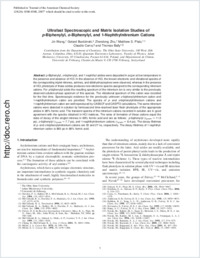Ultrafast Spectroscopic and Matrix Isolation Studies of p-Biphenylyl, o-Biphenylyl, and 1-Naphthylnitrenium Cations
- Wang, Jin Department of Chemistry, The Ohio State University, Columbus, Ohio, USA
- Burdzinski, Gotard Quantum Electronics Laboratory, Faculty of Physics, Adam Mickiewicz University, 85 Umultowska, Poznan, Poland
- Zhu, Zhendong Department of Chemistry, The Ohio State University, Columbus, Ohio, USA
- Platz, Matthew S. Department of Chemistry, The Ohio State University, Columbus, Ohio, USA
- Carra, Claudio Département de Chimie, Université de Fribourg, Switzerland
- Bally, Thomas Département de Chimie, Université de Fribourg, Switzerland
-
13.06.2007
Published in:
- Journal of the American Chemical Society. - 2007, vol. 129, no. 26, p. 8380-8388
English
p-Biphenylyl, o-biphenylyl, and 1-naphthyl azides were deposited in argon at low temperature in the presence and absence of HCl. In the absence of HCl, the known electronic and vibrational spectra of the corresponding triplet nitrenes, azirines, and didehydroazepines were observed, whereas in the presence of HCl, photolysis of these azides produces new electronic spectra assigned to the corresponding nitrenium cations. For p-biphenylyl azide the resulting spectrum of the nitrenium ion is very similar to the previously observed solution-phase spectrum of this species. The vibrational spectrum of this cation was recorded for the first time. Spectroscopic evidence for the previously unknown o-biphenylylnitrenium cation and 1-naphthylnitrenium cation are provided. The spectra of p- and o-biphenylylnitrenium cations and 1-naphthylnitrenium cation are well reproduced by CASSCF and CASPT2 calculations. The same nitrenium cations were detected in solution by femtosecond time-resolved laser flash photolysis of the appropriate azides in 88% formic acid. The transient spectra of the nitrenium cations recorded in solution are in good agreement with the spectra obtained in HCl matrices. The rates of formation of these cations equal the rates of decay of the singlet nitrenes in 88% formic acid and are as follows: p-biphenylyl (θgrowth = 11.5 ps), o-biphenylyl (θgrowth = 7.7 ps), and 1-naphthylnitrenium cations (θgrowth = 8.4 ps). The decay lifetimes of p- and o-biphenylylnitrenium cations are 50 and 27 ns, respectively. The decay lifetimes of 1-naphthylnitrenium cation is 860 ps in 88% formic acid.
- Faculty
- Faculté des sciences et de médecine
- Department
- Département de Chimie
- Language
-
- English
- Classification
- Chemistry
- License
-
License undefined
- Identifiers
-
- RERO DOC 9375
- DOI 10.1021/ja071325j
- Persistent URL
- https://folia.unifr.ch/unifr/documents/300746
Statistics
Document views: 150
File downloads:
- pdf: 219
